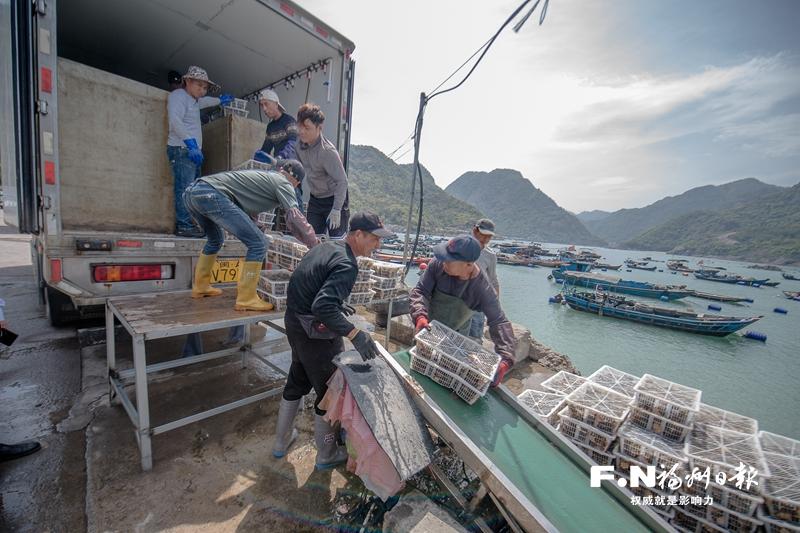Abalone “Takes the Elevator” Straight to the Truck, Leaving the Village in Just 40 Minutes Niu’ao Abalone Makes a Strong Impression
Abalone “Takes the Elevator” Straight to the Truck, Leaving the Village in Just 40 Minutes—
Niu’ao Abalone Makes a Strong Impression
On the morning of April 22, at Niu’ao Wharf in Bili Township, Luoyuan County, baskets of freshly caught abalone were neatly lined up, “riding the elevator”—slowly ascending a 40-meter conveyor belt into a truck, beginning their journey to the cold storage facility. The “abalone elevator” is a daily sight in Niu’ao Village, happening over 30 times a day. Known as “Fujian Abalone Bay,” this fishing village is using technology and innovation to compose a new era of sustainable fishing.

The workers were loading the abalone from the conveyor belt into the truck. (Photo by Liu Qiyi)
A Rich Harvest of Fresh Abalone
A Single Sea Area, Multiple Ways to Boost Income
On the morning of April 22, the sea breeze swept across the wharf as farmer Zheng Xuyi’s boat glided through the thin mist on the water. As the winch turned, plastic boards covered with abalone slowly emerged from the water, and workers swiftly harvested them with their tools. “Bili Bay has excellent water quality, allowing the abalone to reach 7 cm in just 18 months—six months faster than the usual farming cycle,” said the seasoned farmer with eight years of experience, proudly holding up a plump Haliotis discus hannai Ino.
It’s currently the abalone harvest season. While the price has dropped from 50 yuan per jin (0.5 kg) during the Spring Festival to 31 yuan, the daily demand for over 30 truckloads keeps the conveyor belts running non-stop. Zheng Xuyi calculates the profits: with 5,000 cages yielding about 150,000 jin (75,000 kg) of abalone, and accounting for a 20% loss due to typhoon damage, the net profit exceeds one million yuan. Meanwhile, the ripple effect of the abalone industry is benefiting the entire fishing village.
Along with the abalone, Gracilaria lemaneiformis is also being harvested. In Niu’ao Village, the 1,000-mu farming area produces 12,000 tons of Gracilaria lemaneiformis annually, with high-quality mother plants selling for over 2 yuan per jin (0.5 kg). The remainder is repurposed as abalone feed, creating a sustainable ecological cycle. During the harvest season, the wharf employs an average of 30 villagers per day, with pieceworkers earning up to 300 yuan daily.
Harbor Scene
“Two Conveyor Belts, One Crane” Speeds Up Transportation
The two constantly moving conveyor belts at the wharf are a testament to the booming abalone industry in Niu’ao Village.
In the past, fishermen had to manually weigh the abalone on the fish rafts, which often resulted in dehydration. Three years ago, the village self-funded the construction of the province’s first conveyor belt for the fish rafts. The “marine elevator” has since changed the traditional working model. “Now, during the peak harvest season, we weigh more than 20,000 baskets a day, totaling over 100 tons,” said Chen Yizhong, the wharf manager.
The two conveyor belts at the wharf, totaling just 40 meters, have become a vital source of income for the villagers. The abalone is loaded onto trucks from the conveyor belts and then sent to sorting factories in Luoyuan and Mawei, before being distributed to major supermarkets and food processing plants throughout the province.
In the midday sun, the crane’s arm extends smoothly, precisely placing the net bags of Gracilaria lemaneiformis onto the transport ship. “First, we load the net bags onto the ship, then use the crane to unload the Gracilaria lemaneiformis onto the shore,” explained Chen Yizhong.
Improving Facilities
Expanding and Strengthening the Abalone Industry
In the waters of Niu’ao Village, the fish rafts are spread out across the area like stars in the sky. The 5G base station, launched in 2022, has brought fish raft monitoring into the digital age. Mrs. Lin, a local farmer, taps her phone, and the live feed of the farming area pops up on the screen. “I used to worry about the fish rafts being damaged during typhoons, but now I can check the condition of the area anytime, right from my phone,” she said. To better serve abalone farmers, the 5G signal tower in Niu’ao Village will be raised in the future, expanding its coverage area.
Roads are a vital link in opening up sales channels. The reconstruction of the Biniu Line Y022, stretching from National Highway 228 to Niu’ao in Bili Township, was completed in 2023. This “Abalone Express” has cut the time it takes to transport abalone out of the village from 2 hours to just 40 minutes. “After the road was completed, the number of buyers doubled.” Zheng Xuyi’s account book shows the improvements: the transportation loss rate has dropped from 12% to 3%, and the customer base has expanded from the local area to Jiangsu, Zhejiang, and Shanghai.
The township government’s development plan clearly shows the future of Niu’ao Village. “Next, we’ll focus on upgrading the farming facilities and growing the operations of our digital e-commerce platform,” said a relevant official from Bili Township. In the future, Bili Township plans to harness the power of the Luoyuan Abalone Association, pool resources, and expand online sales channels. It aims to promote the Bili “Jibao” brand to a broader market and share the fishermen’s success stories with a wider audience. (Fuzhou Daily Reporter: Ren Siyan; Correspondents: Gao Kunying, Liu Qiyi)